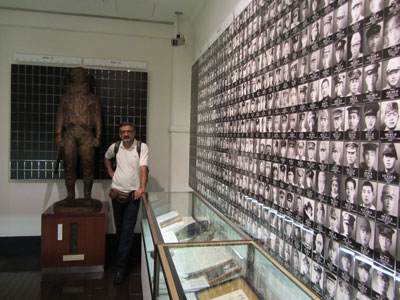Hiroshima travelogue - Part 4
We leave 'The Center of the Tokyo Raids and Was Damage' after taking several pictures with two symbols placed at the entrance door. Next, we head for Yūshūkan military museum in Tokyo. They drive to a different location. Someone says there is the emperor's house over the river and the long rampart we are passing. (What is going on in there? Only God would know.)
Meanwhile, many people are jogging along the pedestrian. Is this the same house where Mehdi Gholi Khan Hedayat accompanied with Ataback met with the Japanese emperor on December 20, 1903 (Ramadan 30, 1321 hg)? I don’t know, but I know that the Iranian Hedayat (Mokhber-o-Saltaneh), known as the globetrotter of his time, was as impressed with Japan as was his compatriot, Hedayatollah, almost 110 years later by seeing the [eastern Asian] country. The impression was not a primeval response to comparing the two countries (Iran and Japan), but stems from a historical question to which various answers have been proposed. Why have we [Iranians] slid back of progression, expansion of laws, institutionalization of social impeccability, exuding self-confidence, professional commitment, and, in a general manner, whatever needed for a better social life? And even if some steps have been taken, why have they been too feeble and unsteady? During these 110 years, four generations have come and gone and what strange events have passed! [The sad thing is that] we have failed to learn from the astonishing order of universe; we have ignored the nature's key to success; we have closed our eyes to the professional commitment of a bumble bee; we have forgotten we are God's greatest creature; ... Will some 110 years later, during another Ramadan, another Hedayat think about such questions? Heaven forbid!

They say these structures are called “Gates of godsâ€. We pass through one of them at the entrance of the museum. We get to a temple. They don’t focus a lot on the temple but many have attached their demands and wishes to it by ropes.
On my right, over the temple, is the museum. It is an official state-run museum. Here is procured everything needed for honoring Japanese comrades, especially those who sacrificed their lives in Kamikaze missions.
The building is relatively large and has numerous halls. It is tastefully arranged and decorated. Besides the display of old items dating back to WWII, the latest technological apparatus has been provided to show the history of the war to the visitors. The museum is a combination of the past life and modern technology.
The museum is established not to forget, but to remember the war; and exhibits no signs of regret or remorse. The whole establishment is constructed to review the heroic acts of Japanese comrades. They say if a Japanese official happens to visit the museum, they would be domestically and internationally censured for reminding the society of Japans' militarism and invasions.
In the end, I wrote a small note in the museum's notebook. This is its final sentence: I hope there will be no wars in the world and honors are not given to people for killing, but for giving life.
To be continued…
By Habibollah Behboudi
Translated into English by Abbas Hajihashemi
Number of Visits: 4847








The latest
- The Embankment Wounded Shoulders – 14
- An Eternal Lie!
- The 368th Night of Remembrance – Part 2
- Agents in Search for the Fighter
- The Embankment Wounded Shoulders – 13
- The Necessity of Standardizing Oral History and Criticism of General Mohsen Rezaei
- The 368th Night of Remembrance – Part 1
- Oral History News of Khordad 1404 (May 22nd – June 21st 2025)
Most visited
- Oral History News of Khordad 1404 (May 22nd – June 21st 2025)
- Najaf Headquarters Human Resources
- The Necessity of Standardizing Oral History and Criticism of General Mohsen Rezaei
- The 368th Night of Remembrance – Part 1
- The Embankment Wounded Shoulders – 13
- Agents in Search for the Fighter
- An Eternal Lie!
- The 368th Night of Remembrance – Part 2
How to send Imam's announcements to Iran
In the first part, the issue of funds, Hajj Sheikh Nasrallah Khalkhali - who represented most of the religious authorities - was also the representative of Imam. In Najaf, there was a money exchange office that cooperated with the money exchange offices in Tehran. Some of the funds were exchanged through him.Operation Beit al-Moqaddas and Liberation of Khorramshahr
After Operation Fat’h al-Mobin, we traveled to Kermanshah and visited Sar-e-Pol-e-Zahab before heading to Ilam. During Operation Beit al-Moqaddas, the 27th Brigade was still receiving support from the West. We maintained contact with individuals who had previously worked in Area 7 and were now leading the brigade. It was through these connections that I learned about Operation Beit al-Moqaddas.Memoirs of Hujjat al-Islam Reza Motalebi
Hujjat al-Islam Reza Motalebi is a cleric from Isfahan. Before the revolution, he was the imam of the Fallah Mosque – which was later renamed Abuzar Mosque. By his presence and efforts, Abuzar Mosque soon became a base for supporters of the Imam and the revolution. After the victory of the revolution, he played a role in uniting forces and maintaining political vitality in southwest Tehran.The Necessity of Receiving Feedback in Oral History
Whenever we engage in a task, we naturally seek ways to evaluate our performance — to correct shortcomings and enhance strengths. Such refinement is only possible through the feedback we receive from others. Consider, for instance, a basketball player whose shots are consistently accurate; should he begin shooting blindfolded, his success rate would rapidly decline, as he would be deprived of essential feedback from each attempt.

